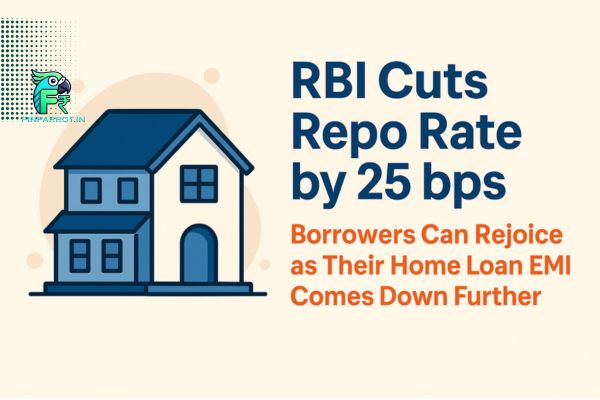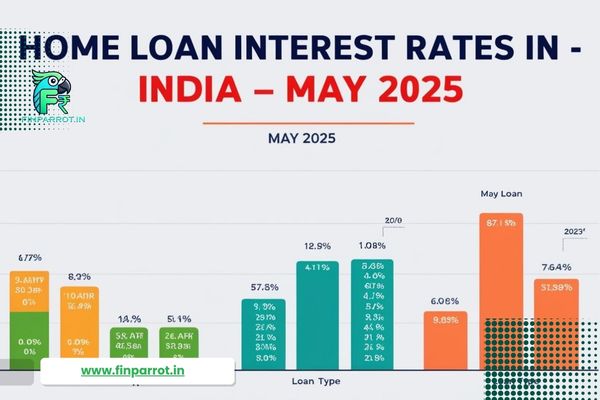Introduction
Interest rates can be confusing, right? Especially here in India, where many of us find it tough to see how they really impact our monthly bills and the overall debt we carry. That’s why I put together this guide on 4 Types of Interest Rates Just to Know to break down the four main types of interest you really need to understand. Whether you’re looking at a home loan, a personal loan, or just trying to figure out your credit card, knowing these things helps you make much better money choices. We’ll look at some real-life examples and learn how to avoid common financial mistakes. Understanding these interest types is truly crucial for managing your finances. So, let’s start with the four essentials.
Discover how loan tenure impacts your eligibility and interest rates in detail Click Here.
Fixed Interest Rates
Fixed interest rates remain constant throughout the tenure of a loan. When you choose a fixed rate for a loan, your EMI (Equated Monthly Installment) stays the same regardless of any market fluctuations. This consistency is particularly beneficial for long-term loans like home or car loans. For example, if you take a home loan of ₹10,00,000 at a fixed rate of 8% per annum, your EMI remains unchanged throughout the loan period, enabling consistent budgeting and protecting you from any unexpected hikes in interest rates.
Pros:
- Predictability and stability in monthly payments.
- Easier budgeting as the EMI remains constant.
- Protection against rising market rates.
Cons:
- Often comes with a higher initial rate compared to variable options.
- Limited benefit from potential future declines in market interest rates.
Best for:
Fixed interest rates are always the best choice for borrowers who prefer consistency and a predictable repayment schedule. They work best for long-term loans such as home loans and car loans, where stable payments are critical. For example, if you plan to repay your home loan over 20 years and want to avoid surprises in your monthly expenses, a fixed rate loan is the preferred choice.
Variable (Floating) Interest Rates
Variable interest rates, also known as floating rates, fluctuate according to market conditions. These rates are often linked to a benchmark, such as the repo rate set by the Reserve Bank of India. (You can find the current repo rate here: [Link to RBI Website]). For instance, if you secure a personal loan of ₹5,00,000 with an initial variable rate of 7.5% per annum, your interest rate—and consequently your EMI—may vary over time. If the rate drops by 0.5%, your EMI might decrease, saving you money; however, if the rate rises, your EMI will increase, which can make long-term budgeting more challenging.
Pros:
- Initially lower interest rates compared to fixed options.
- Possibility of reduced EMIs if market rates decline.
Cons:
- Uncertainty due to market volatility.
- Fluctuating EMIs can complicate long-term financial planning.
Best for:
Variable interest rate loans are best for borrowers who are comfortable with a degree of uncertainty and are looking for initial cost savings. They work well for loans with a shorter tenure or when you expect a decrease in market rates. For example, if you take a consumer durable loan (loans for purchasing appliances or electronics with repayment terms of 1-3 years) or a short-term personal loan and plan to repay it within a few years, a variable rate can offer initial savings, provided you are prepared for potential rate hikes.
Uncover 30 hidden loan charges and learn how to avoid them Click Here.
Simple Interest
Simple interest on loans is calculated solely on the principal amount, without any compounding. This straightforward method makes it easy to understand how much interest you’ll pay over the loan’s duration. For example, if you take a loan of ₹5,00,000 at an annual simple interest rate of 10%, you will pay ₹50,000 in interest per year. Over a three-year term, the total interest paid would be ₹1,50,000, with the interest calculated only on the original principal amount. It is important to note that simple interest is typically used for very short-term loans, or loans where the principal is paid back in one lump sum at the end of the loan period.
Pros:
- Clear and easy-to-calculate interest amounts.
- Often results in lower overall interest for short-term loans.
Cons:
- No benefit of earning “interest on interest” for the lender, which can sometimes be a drawback for long-term financing products.
- Less commonly applied to longer-term loans compared to compound interest methods.
Best for:
Simple interest loans are most suitable for short-term loans, where the repayment period is not long enough to benefit from compounding. For instance, auto loans or short-duration personal loans often use simple interest calculations, making it easier for borrowers to understand their cost of borrowing without the complexity of compounded calculations.
Compound Interest
Compound interest on loans involves calculating interest on both the original principal and the accumulated interest from previous periods. This method can result in higher costs if not managed properly. For example, if you take a loan of ₹5,00,000 at a compound interest rate of 10% per annum, after one year, you might owe ₹5,50,000. In the second year, interest is calculated on ₹5,50,000, not just the original ₹5,00,000, leading to a higher effective cost.
Compounding Frequency Explained:
The frequency of compounding significantly influences the final interest amount. With yearly compounding, interest is added once per year; with monthly compounding, interest is added twelve times a year; and with daily compounding, interest is calculated and added every day. More frequent compounding leads to higher overall interest costs on a loan, making it crucial for borrowers to understand how often the interest is compounded.
Pros:
- Reflects the true cost of borrowing when interest is reinvested regularly.
- Provides a more accurate calculation for long-term loans where interest accrues over time.
Cons:
- Can lead to rapidly increasing debt if repayments are not managed carefully.
- More complex calculations require careful monitoring of the compounding frequency to avoid surprises in the total payable amount.
Best for:
Compound interest loans are generally used for long-term financing, where the effect of accumulating interest becomes significant. They are common in certain types of personal loans or refinancing options. For example, if you take a long-term personal loan or a refinancing option where the interest compounds monthly, you must be aware that the total amount payable may be higher compared to a simple interest calculation, especially if the compounding frequency is high.
Simple vs. Compound Interest:
Here’s the table in a clean format:
| Year | Simple Interest (10% on ₹5,00,000) | Compound Interest (10% Annual) |
| 1 | ₹5,50,000 | ₹5,50,000 |
| 2 | ₹6,00,000 | ₹6,05,000 |
| 3 | ₹6,50,000 | ₹6,65,500 |
| 5 | ₹7,50,000 | ₹8,05,255 |
| 10 | ₹10,00,000 | ₹12,96,871 |
Best Practices & Mistakes to Avoid
Best Practices:
- Compare Lenders: Always review multiple options before settling on a loan product.
- Plan Ahead: Understand the long-term implications of the interest type chosen.
- Stay Informed: Keep up with market trends, especially for variable and introductory rates.
- Use Financial Tools: Utilize EMI calculators (you can find examples online) and budget planners for accurate projections.
Common Mistakes:
- Ignoring Hidden Charges: Don’t overlook fees or additional costs that might be embedded in the loan terms.
- Not Reading the Fine Print: Details matter—ensure you understand every clause before signing any agreement.
- Overlooking Market Trends: With variable rates, failing to monitor market changes can lead to financial surprises.
- Focusing Solely on Low Initial Rates: A seemingly attractive introductory offer may lead to higher costs later.
Tax Implications (India Specific):
In India, interest paid on certain loans can offer tax benefits. For example, interest paid on home loans under Section 24(b) and principal repayments under Section 80C of the Income Tax Act can provide deductions. It’s advisable to consult a tax advisor for specifics and to understand how these benefits can lower your overall financial burden.
Glossary
- Repo Rate: The interest rate at which the Reserve Bank of India lends money to commercial banks.
- EMI (Equated Monthly Installment): A fixed payment amount made by a borrower to a lender at a specified date each month to repay a loan.
- Principal: The original sum of money borrowed in a loan, excluding any interest or fees.
- Compounding Frequency: The number of times interest is calculated and added to the principal in a given period (yearly, monthly, daily).
- Don’t fall for these 7 common CIBIL score myths—get the facts Click Here.
FAQ’s
Review the loan agreement or disclosure documents, which should specify the interest calculation method, to identify whether a loan uses simple or compound interest. The Truth in Lending Act also requires lenders to disclose whether interest is simple or compounded. Assess your financial stability and risk tolerance. A fixed-rate may be suitable if you prefer consistent payments and plan to stay long-term. A floating rate could be advantageous if you're comfortable with potential fluctuations and aim to benefit from possible rate decreases.
How can I determine if a loan uses simple or compound interest?
If I take a ₹30 lakh home loan, should I choose a fixed or floating interest rate?
Conclusion
When it comes to loans, selecting the right type of interest rate is essential for managing your monthly payments and overall financial health. Whether you opt for the stability of fixed rates, the initial affordability of variable rates, the clarity of simple interest, or the comprehensive yet potentially costlier compound interest, each type has its own unique benefits and drawbacks. Consider your financial situation, repayment horizon, and risk tolerance when choosing a loan. Consult with financial experts if needed, and leverage these insights to build a repayment strategy that works best for you.
Ready to take control of your loan decisions? Explore your options today and make informed choices that set you on the path to financial success!
Disclaimer: This article is for informational purposes only and should not be considered financial advice.















